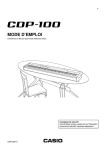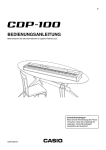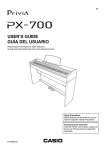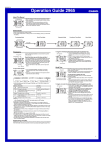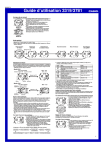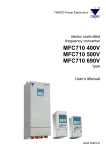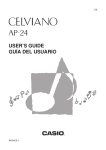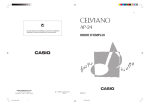Download Casio CDP-100 User`s guide
Transcript
ES USER’S GUIDE GUÍA DEL USUARIO Please keep all information for future reference. Guarde toda información para tener como referencia futura. Safety Precautions Before trying to use the piano, be sure to read the separate “Safety Precautions”. Precauciones de seguridad Antes de intentar usar el piano, asegúrese de leer las “Precauciones de seguridad” separadas. CDP100ES1A TO REDUCE THE RISK OF FIRE OR ELECTRIC SHOCK, REFER SERVICING TO QUALIFIED SERVICE PERSONNEL. IMPORTANT SAFETY INSTRUCTIONS 1. 2. 3. 4. 5. 6. 7. 8. 9. 10. 11. 12. Read these instructions. Keep these instructions. Heed all warnings. Follow all instructions. Do not use this apparatus near water. Clean only with dry cloth. Do not block any ventilation openings. Install in accordance with the manufacturer’s instructions. Do not install near any heat sources such as radiators, heat registers, stoves, or other apparatus (including amplifiers) that produce heat. Do not defeat the safety purpose of the polarized or grounding-type plug. A polarized plug has two blades with one wider than the other. A grounding type plug has two blades and a third grounding prong. The wide blade or the third prong are provided for your safety. If the provided plug does not fit into your outlet, consult an electrician for replacement of the obsolete outlet. Protect the power cord from being walked on or pinched particularly at plugs, convenience receptacles, and the point where they exit from the apparatus. Only use attachments/accessories specified by the manufacturer. Use only with the cart, stand, tripod, bracket, or table specified by the manufacturer, or sold with the apparatus. When a cart is used, use caution when moving the cart/apparatus combination to avoid injury from tip-over. 13. Unplug this apparatus during lightning storms or when unused for long periods of time. 14. Refer all servicing to qualified service personnel. Servicing is required when the apparatus has been damaged in any way, such as power-supply cord or plug is damaged, liquid has been spilled or objects have fallen into the apparatus, the apparatus has been exposed to rain or moisture, does not operate normally, or has been dropped. The apparatus shall not be exposed to dripping or splashing and that no objects filled with liquids, such as vases, shall be placed on the apparatus. The power indicator being unlit does not mean the apparatus is completely disconnected from the MAINS. When you need to have the apparatus completely disconnected from the MAINS, you must unplug the power cord. For that purpose, locate the apparatus in a way that secures easy access to the power cord. NOTICE This equipment has been tested and found to comply with the limits for a Class B digital device, pursuant to Part 15 of the FCC Rules. These limits are designed to provide reasonable protection against harmful interference in a residential installation. This equipment generates, uses and can radiate radio frequency energy and, if not installed and used in accordance with the instructions, may cause harmful interference to radio communications. However, there is no guarantee that interference will not occur in a particular installation. If this equipment does cause harmful interference to radio or television reception, which can be determined by turning the equipment off and on, the user is encouraged to try to correct the interference by one or more of the following measures: • Reorient or relocate the receiving antenna. • Increase the separation between the equipment and receiver. • Connect the equipment into an outlet on a circuit different from that to which the receiver is connected. • Consult the dealer or an experienced radio/TV technician for help. FCC WARNING Changes or modifications not expressly approved by the party responsible for compliance could void the user’s authority to operate the equipment. Important! Please note the following important information before using this product. • Before using the AD-12 Adaptor to power the unit, be sure to check the AC Adaptor for any damage first. Carefully check the power cord for breakage, cuts, exposed wire and other serious damage. Never let children use an AC adaptor that is seriously damaged. • The product is not intended for children under 3 years. • Use only CASIO AD-12 adaptor. • The AC adaptor is not a toy. • Be sure to disconnect the AC adaptor before cleaning the product. This mark applies in EU countries only. CASIO Europe GmbH Bornbarch 10, 22848 Norderstedt, Germany 403A-E-002A Contents General Guide .......................... E-2 Attachment of the Score Stand .................. E-2 Company and product names used in this manual may be registered trademarks of others. Playing Back the Built-in Demo Tunes ....... E-3 Power Supply ........................... E-4 Using the AC Adaptor ................................. E-4 Connections ............................. E-5 Connecting Headphones ............................ E-5 Connecting to a DAMPER PEDAL Jack ..... E-5 Playing with Different Tones ... E-6 Selecting and Playing a Tone ..................... E-6 Using Tone Effects ...................................... E-6 Layering Two Tones .................................... E-7 Other Settings .......................... E-8 Changing the Keyboard Touch ................... E-8 Changing the Pitch of the Piano to Match Another Instrument ..................................... E-8 Changing the Piano Key ............................. E-8 Using MIDI .................................................. E-9 Troubleshooting ..................... E-10 Specifications......................... E-11 Operational Precautions ....... E-12 Locating the Unit ....................................... E-12 Care of the Unit ......................................... E-12 MIDI Implementation Chart 403A-E-003A E-1 General Guide Back Panel Attachment of the Score Stand Insert the score stand into the slot at the top of the digital piano as shown in the illustration. 1 Left Side Panel 2 6 3 4 7 5 8 9 0 A NOTE • Each chapter of this manual starts with an illustration of the piano’s console, which shows the buttons and other controllers you need to operate. E-2 FUNCTION REVERB CHORUS 403A-E-004A General Guide 1 DAMPER PEDAL jack 7 FUNCTION button 2 POWER button 8 PLAY/STOP, DEMO button 3 DC 12V jack 9 SONG SELECT buttons 4 MIDI OUT/IN terminals 0 TONE buttons 5 PHONES jack A REVERB CHORUS button 6 VOLUME knob NOTE • Key, button, and other names are indicated in the text of this manual using bold type. Playing Back the Built-in Demo Tunes This digital piano comes with 5 built-in demo tunes, each of which features one of the built-in tones. To play the built-in tunes in sequence 1 While holding down the FUNCTION button, press the PLAY/STOP button. 2 Press the PLAY/STOP button again to stop the tune play. • This starts sequential playback of the built-in tunes. • You can play along with the built-in tunes on the keyboard, if you want. Tone assigned to the keyboard is the one that is preset for the built-in tune that is playing. • You can also cycle through the available tunes by holding down the FUNCTION button and pressing the SONG SELECT [ ] or [ ] button. Title Composer Play Time GRAND PIANO 1 Étude Op.25-9 F.F.Chopin 0:56 GRAND PIANO 2 NorwegischeTänze 2 E.Grieg 1:45 Original – 1:49 Gavotte [Französische Suite 5] J.S.Bach 0:43 Intermezzo Sinfonico [Cavalleria Rusticana] P.Mascagni 1:49 Tone ELEC PIANO HARPSICHORD STRINGS 403A-E-005A E-3 General Guide To play a specific built-in tune 1 While holding down the FUNCTION button, press the SONG SELECT [ through the available tunes. 2 Press the PLAY/STOP button. 3 Press the PLAY/STOP button again to stop tune play. ] or [ ] button to cycle • This starts the playback of the tune in an endless loop. Power Supply You can power this digital piano by plugging it into a standard household power outlet. Be sure you turn off power and unplug the power cord from the electrical outlet whenever the digital piano is not in use. Using the AC Adaptor Make sure that you use only the AC adaptor specified for this digital piano. Specified AC Adaptor: AD-12 [Left Side Panel] DC 12V jack AC adaptor AD-12 Note the following important precautions to avoid damage to the power cord. ● During Use • Never pull on the cord with excessive force. • Never repeatedly pull on the cord. • Never twist the cord at the base of the plug or connector. • The power cord should not be stretched tight while it is in use. ● During Movement • Before moving the keyboard, be sure to unplug the AC adaptor from the power outlet. ● During Storage • Loop and bundle the power cord, but never wind it around the AC adaptor. IMPORTANT! • Make sure that the product is turned off before connecting or disconnecting the AC adaptor. • Using the AC adaptor for a long time can cause it to become warm to touch. This is normal and does not indicate malfunction. AC outlet E-4 403A-E-006A Connections IMPORTANT! • Whenever connecting external equipment, first set the VOLUME knob of the digital piano and the volume controller of the external equipment to relatively low volume settings. You can later adjust volume to the level you want after connections are complete. • Be sure also to refer to the documentation that comes with the external equipment for its proper connection procedures. Connecting to a DAMPER PEDAL Jack Connect the pedal’s cable to the digital piano’s DAMPER PEDAL jack. Pressing this pedal causes notes to reverberate and to sustain longer. [Back Panel] Connecting Headphones DAMPER PEDAL jack Connect commercially available headphones to the digital piano’s PHONES jack. This cuts off the builtin speakers, which means you can practice even late at night without disturbing others. To protect your hearing, make sure that you do not set the volume level too high when using headphones. [Left Side Panel] PHONES jack SP-3 Headphones Accessories and Options Use only the accessories and options specified for this digital piano. Use of non-authorized items creates the danger of fire, electric shock, and personal injury. 403A-E-007A E-5 Playing with Different Tones Selecting and Playing a Tone The piano comes with 5 built-in tones. 1 Using Tone Effects Reverb: Makes your notes resonate Chorus: Adds more breadth to your notes Press the POWER button. 1 • You can find out the current reverb/chorus configuration by looking at the REVERB and CHORUS indicator lamps. POWER button 2 Press the REVERB CHORUS button to cycle through the effect settings as shown below. Use the VOLUME knob to adjust the volume level. Both on • Before playing, it is a good idea to set the volume to a relatively low level. 3 Both off Press the TONE button of the tone you want to select. Reverb on 4 Now try playing something on the keyboard. Chorus on Tone Name GRAND PIANO 1 GRAND PIANO 2 ELEC PIANO HARPSICHORD STRINGS Maximum Polyphony 16 32 32 16 32 Selecting an Effect You can select from among four reverb effects and four chorus effects by pressing the keyboard keys shown below. 1 Reverb Effect Keys Room 2 Hall 2 Hall 1 Room 1 ▲ C1 ▲ C2 ▲ C3 ▲ C4 ▲ C5 ▲ C6 ▲ C7 ▲ C8 2 Chorus Effect Keys Chorus 2 Chorus 1 VOLUME E-6 FUNCTION TONE Chorus 4 Chorus 3 REVERB CHORUS 403A-E-008A Playing with Different Tones 1 While holding down the FUNCTION button, press one of the keyboard keys shown above. Adjusting the Volume of Layered Tones 1 While holding down the FUNCTION button, use the keyboard keys shown below to adjust the volume of the layered tones. + – ▲ C1 ▲ C2 ▲ C3 ▲ C4 ▲ C5 ▲ C6 ▲ C7 ▲ C8 + : Raises the volume – : Lowers the volume Layering Two Tones Use the following procedure to layer to two tones, so they sound at the same time. 1 Simultaneously press the TONE buttons of the two tones that you want to layer. Example: Press GRAND PIANO 2 button and STRINGS button at the same time. GRAND PIANO 2 STRINGS • The tones are now layered. 2 403A-E-009A After you are finished using the layered tones, press the one of the TONE buttons again to unlayer them. E-7 Other Settings Changing the Keyboard Touch 1 This setting changes the relative touch of the keyboard keys. Changing the Pitch of the Piano to Match Another Instrument 2 Use this setting to raise or lower the overall pitch of the piano. The setting range is plus or minus 50 cents (100 cents = 1 semitone) from the standard pitch of A4 = 440.0Hz. 1 Changing the Keyboard Touch Off Weak (Strong sound is produced even when relatively light pressure is applied.) Normal Strong (Normal sound is produced even when relatively strong pressure is applied.) 2 Changing the Pitch of the Piano to Match Another Instrument +: Raise – : Lower * Each press of a key changes the current setting by approximately 1 cents (1/100 semitone). NOTE Changing the Piano Key 3 Use this setting to raise or lower the overall key of the keyboard in semitone steps. While holding down the FUNCTION button, use the keyboard keys shown below to select the keyboard setting you want. 1 • Holding down the FUNCTION button and pressing keyboard keys “–” and “+” at the same time returns tuning to the standard A4 = 440.0Hz. 3 Changing the Piano Key Higher (C to F) Normal (C) Lower (F to B) 1 Weak Normal Off ▲ C1 Strong ▲ C2 ▲ C3 ▲ C4 ▲ C5 ▲ C6 ▲ C7 ▲ C8 3 2 + : Raise – : Lower Lower Higher C2 : Normal FUNCTION E-8 403A-E-010A Other Settings MIDI Settings Using MIDI 1 Send Channel Use this setting to specify one of the MIDI channels (1 through 16) as the Send Channel for sending MIDI messages to an external device. What is MIDI? The letters MIDI stand for Musical Instrument Digital Interface, which is the name of a worldwide standard for digital signals and connectors that makes it possible to exchange musical data between musical instruments and computers (machines) produced by different manufacturers. MIDI Connections 2 Local Control This setting controls whether or not power is cut off internally from the piano’s keyboard and sound source. Turning off Local Control cuts off power to the keyboard and source, which means that the piano does not produce any sound when played. This comes in handy when you want to turn off the piano’s keyboard and use its auto accompaniment feature to accompany an external sequencer or other device. Send 1 MIDI cabel: MK-5 While holding down the FUNCTION button, press one the keyboard keys shown below to configure the setting you want. 1 Sender OUT IN + Receiver MIDI musical instrument MIDI sound module MIDI sequenser Other MIDI device 2 On – Off Receive ▲ C1 MIDI cable: MK-5 Receiver IN OUT Sender MIDI musical instrument MIDI sequencer Other MIDI device ▲ C2 ▲ C3 ▲ C4 ▲ C5 ▲ C6 ▲ C7 ▲ C8 1 Send Channel – : Decreases value +: Increases value 2 Local Control Off On Program Change Tone Name Program Change GRAND PIANO 1 0 GRAND PIANO 2 1 ELEC PIANO 2 HARPSICHORD 3 STRINGS 4 403A-E-011A Bank Select MSB 0 0 0 0 0 E-9 Troubleshooting Symptom Possible Cause Action Reference No sound produced when 1. VOLUME knob set to MIN. 1. Move the VOLUME knob more Page E-6 keyboard keys are pressed. towards MAX. 2. Headphones connected to the 2. Disconnect the headphones Page E-5 from the digital piano. digital piano. 3. Turn on Local control. 3. Local Control turned off. Page E-9 Keyboard out of tune. 1. The piano key is set to a value 1. Change the piano key setting to Page E-8 other than C. C, or turn the digital piano power off and then back on again. 2. Incorrect pitch setting of the 2. Correct the pitch setting, or turn Page E-8 the digital piano power off and piano. then back on again. No sound produced by demo tune 1. VOLUME knob set to MIN. 1. Move the VOLUME knob more Page E-6 play. towards MAX. 2. Headphones connected to the 2. Disconnect the headphones Page E-5 from the digital piano. digital piano. No sound produced by connected 1. The digital piano Send Channel 1. Change the Send Channel external MIDI sound source when does not match the Send settings so they are identical. the digital piano keys are pressed. Channel of the MIDI sound source. 2. Volume or expression setting of 2. Change the volume or the external sound source is set expression setting of the to 0. external sound source to an appropriate value. E-10 Page E-9 See the documentation that comes with the external sound source. 403A-E-012A Specifications Models: CDP-100 Keyboard: 88 piano keys (with touch response) Polyphony: 32 notes, maximum Tones: 5; with layer Digital Effects: Reverb (4 types), Chorus (4 types) Built-in Tunes: 5 Pedal: Damper Other Functions: • Touch: 3 types, off • Transpose: 1 octave (F to C to F) • Tuning: A4 = 440.0Hz ±50 cents (adjustable) MIDI: 16 multi-timbre receive Input/Output: • Headphones: Stereo mini jack Output Impedance: 170Ω Output Voltage: 4.8V (RMS) MAX • Pedal: Standard jack • Power: 12V DC • MIDI (OUT) (IN) Speakers: (12cm × 6cm) × 2 (Output: 8.0W + 8.0W) Power Supply: AC Adaptor: AD-12 Power Consumption: 12V Dimensions: 132.3 × 27.8 × 13.2 cm (52 2/16 × 10 15/16 × 5 3/16 inch) Weight: Approximately 11.2 kg (24.7 lbs) 18W • Design and specifications are subject to change without notice. 403A-E-013A E-11 Operational Precautions Locating the Unit Avoid the following locations. • Areas exposed to direct sunlight and high humidity • Areas subjected to very low temperatures • Near a radio, TV, video deck, or tuner (unit can cause interference with audio or video signals) You may notice lines in the finish of the case of this product. These lines are the result of the molding process used to shape the plastic of the case. They are not cracks or breaks in the plastic, and are no cause for concern. NOTE Care of the Unit • Never use benzene, alcohol, thinner or other such chemicals to clean the exterior of the unit. • To clean the keyboard, use a soft cloth dampened with a weak solution of a mild neutral detergent and water. Wring out all excess moisture from the cloth before wiping. E-12 • Unauthorized reproduction of this manual in its entirety or in part is expressly forbidden. All rights reserved. • CASIO COMPUTER CO., LTD. shall not be held liable for any damages or losses or any claims by third parties arising from use of this product or this manual. • The contents of this manual are subject to change without notice. 403A-E-014A MIDI Implementation Chart Model CDP-100 Function ... Transmitted Recognized Basic Channel Default Changed 1 1-16 1-16 1-16 Mode Default Messages Altered Mode 3 X ❊❊❊❊❊❊❊❊❊❊❊❊❊❊ Mode 3 X True voice 21-108 ❊❊❊❊❊❊❊❊❊❊❊❊❊❊ 0-127 0-127 Velocity Note ON Note OFF O 9nH V = 1-127 X 8nH V = 64 O 9nH V = 1-127 X 9nH V = 0,8nH V = ** After Touch Key’s Ch’s X X X X X O O X O*1 O O O O X X O O O X O O O O*1 O O O O O O O O O O O Note Number Pitch Bender 0, 32 1 6, 38 7 10 11 64 66 67 91 93 100, 101 120 121 Control Change Program Change :True # O 0-4 ❊❊❊❊❊❊❊❊❊❊❊❊❊❊ O*2 O*2 System Common : Song Pos : Song Sel : Tune X X X X X X System Real Time : Clock : Commands X X X X Aux : Local ON/OFF : All notes OFF : Active Sense : Reset X X X X X O O X Remarks Mode 1 : OMNI ON, POLY Mode 3 : OMNI OFF, POLY 403A-E-031A Remarks **: no relation **: sin relación Bank select Modulation Data entry Volume Pan Expression Hold1 Sostenuto Soft pedal Reverb send Chorus send RPN LSB, MSB All sound off Reset all controller O 0-4 ❊❊❊❊❊❊❊❊❊❊❊❊❊❊ System Exclusive Messages Version: 1.0 *1 Fine tune and coarse tune send/receive, RPN Null, and pitch bend sense receives *1 Afinación fina y envío/recepción de afinación gruesa, RPN nulo y recepción de captación de inflexión de altura tonal. *2 • Reverb type [F0][7F][7F][04][05][01][01][01][01][01][00][vv][F7] vv=00: Room1, 01: Room2, 04: Hall1, 03: Hall2 • Chorus type [F0][7F][7F][04][05][01][01][01][01][02][00][vv][F7] vv=00: Chorus1, 01: Chorus2, 02: Chorus3, 03: Chorus4 *2 • Tipo de reverberación [F0][7F][7F][04][05][01][01][01][01][01][00][vv][F7] vv=00: Room1, 01: Room2, 04: Hall1, 03: Hall2 • Tipo de chorus [F0][7F][7F][04][05][01][01][01][01][02][00][vv][F7] vv=00: Chorus1, 01: Chorus2, 02: Chorus3, 03: Chorus4 Mode 2 : OMNI ON, MONO Mode 4 : OMNI OFF, MONO O : Yes X : No This recycle mark indicates that the packaging conforms to the environmental protection legislation in Germany. Esta marca de reciclaje indica que el empaquetado se ajusta a la legislación de protección ambiental en Alemania. CASIO COMPUTER CO.,LTD. 6-2, Hon-machi 1-chome Shibuya-ku, Tokyo 151-8543, Japan P MA0505-A Printed in China CDP100ES1A
















